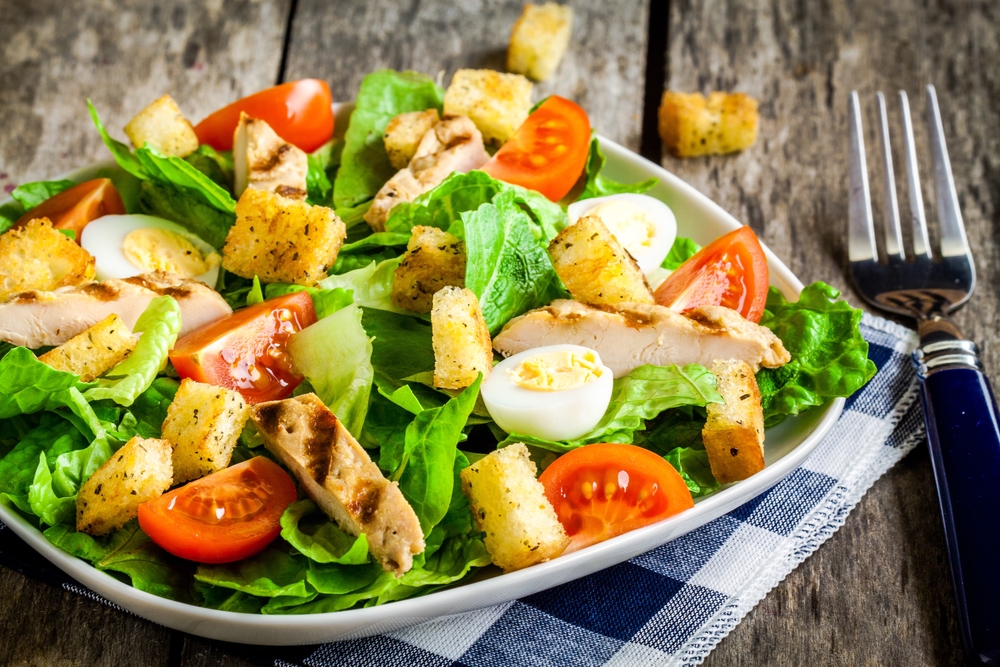Healthy, delicious salad recipe ideas for seniors can pose a challenge for nursing home and care center food service teams.
The problem is that seniors often dislike salad, as many of them never included salads as a part of their diet when living at home. Dressing a salad up to make it appetizing can quickly turn a healthy dish into a nutritional disaster, easily racking up hundreds of calories and excessive amounts of fat, sodium and sugar.

Fortunately, creating healthy and appetizing salads isn’t difficult or time-consuming when you use these six dietitian tips.
No. 1: Choose the Right Greens
Do not skimp on the leafy greens. In fact, aim to cover about three-fourths of the plate.
But, don’t just pile up any type of lettuce. Swap out the iceberg for a mix of darker greens, such as romaine, spinach or kale. These power greens have more vitamins and minerals, which is always a plus in recipe ideas for seniors.
No. 2: Increase the Veggie Content
Greens are the foundation of a healthy salad, but adding other veggies provides a major nutritional and flavor boost. Plus, their different textures make healthier salads much more appealing.
The sky’s the limit when it comes to salad-friendly veggies. Popular choices among seniors include tomatoes, carrots, bell peppers, red cabbage, cucumbers, radishes, peas and red onions.
No. 3: Don’t Forget the Fruit
Fruit adds extra nutrition and a little sweetness to a salad. Not only will this lessen the need for tons of dressing, but it can also help offset the bitterness of darker varieties of greens.
Try adding a few sliced strawberries, orange sections or pineapple tidbits. Or, toss in some blueberries, cranberries or melon chunks. Diced apple or pear also works particularly well in a salad recipe for seniors.
No. 4: Add a Single Protein
Older adults need about 5 to 7 ounces of protein each day. So dietitians recommend including meat, cheese, hard-boiled eggs, nuts or beans in salad recipe ideas for seniors – particularly if the dish is meant to serve as the primary course.
However, don’t add all of those proteins at once. Choose just one, or the calories of the salad could get out of control.
No. 5: Go Easy on the Empty-Calorie Extras
Who doesn’t love a little extra crunch and flavor on a salad? Many seniors expect to see croutons, chow mein noodles or tortilla strips on their salads.
The problem is that these extras can greatly increase the calorie count and sodium content of the disk. Instead of scooping on the toppings, crush a tablespoon or two and sprinkle it over the salad. Seniors will get the crunch they want, without as much added fat and calories.
Even better, switch to a healthy crunch such as seeds or nuts. Use sunflower seeds, pepitas or sliced almonds. Be careful, however, as even healthy add-ins like these quickly up the calorie count of the dish.
No. 6: Choose a Healthier Salad Dressing
Creamy dressings, including blue cheese, ranch, French and Thousand Island are high in saturated fat and calories. In fact, salad dressing is the most common way to turn a healthy salad into a nutritional disaster.
Light versions are available; however, many of these dressings are higher in sugar and chemicals.
Oil-based dressings, or vinaigrettes, are generally healthier than creamy dressings, especially if you make your own. By following dietitian-approved recipe ideas – rather than reaching for a bottle – you can better control the fat, calories and sodium.
Making your own dressing is healthy for your residents, takes only takes a few minutes and – if done consistently – you will be surprised how much it can cut your food budget.
Making healthy salads for seniors is easy with the Grove Menus advanced meal planning program. Contact us today for a free demonstration of our menu planning system, complete with hundreds of dietitian-approved recipe ideas for seniors.
